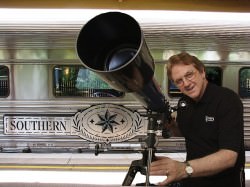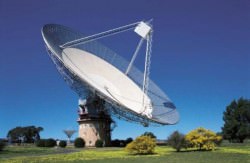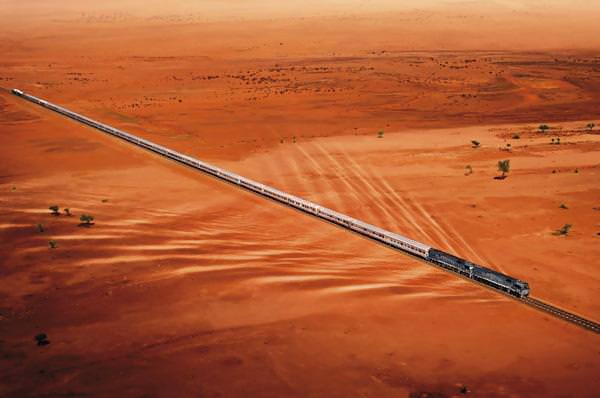While this desolate looking red landscape looks like it might be part of the Martian surface, it’s actually a bit closer to home. The Great Southern Rail, which launched a luxury train crossing Australia from Darwin to Adelaide, has christened one of its lines the “Ghan” after the original ships of the desert – camels – and its other line the Southern Spirit. The Southern Spirit joins the Ghan, which runs south to north, and the Indian Pacific, which runs east to west, as a grand rail adventure of world standard. The remarkable difference about the Southern Spirit is that it will traverse the country both east to west and north to south and offer an adventure you might never associate with a rail trip… Astronomy!
 Astronomer Dave Reneke from Australasian Science magazine was invited by Great Southern Railways to take part in the inaugural rail journey of Spirit across Australia as a “stellar” guest speaker on this astronomy themed journey. He and partner Robin were part of the initial journey, following a route from Uluru and Alice Springs, down into South Australia then across to Melbourne and into southern NSW. But these trips are more than just a ride, the exclusive tours are designed so you can pause and savor the essence of Australia as The Southern Spirit winds its way through a rich tapestry of landscapes. “It’s an amazing country and the outback skies are so clear,” David said. “The passengers loved it, and we did too!”
Astronomer Dave Reneke from Australasian Science magazine was invited by Great Southern Railways to take part in the inaugural rail journey of Spirit across Australia as a “stellar” guest speaker on this astronomy themed journey. He and partner Robin were part of the initial journey, following a route from Uluru and Alice Springs, down into South Australia then across to Melbourne and into southern NSW. But these trips are more than just a ride, the exclusive tours are designed so you can pause and savor the essence of Australia as The Southern Spirit winds its way through a rich tapestry of landscapes. “It’s an amazing country and the outback skies are so clear,” David said. “The passengers loved it, and we did too!”
 David gave a series of lectures each time on-board the train and organized a night at the ‘Dish’ – the famous Parkes Radio telescope. The Parkes telescope was built about the same time as the Green Bank 140 foot telescope, but it has an excellent alt-az design and is still in active use, with multibeam receivers making HI and pulsar surveys of the southern sky. However, its claim to international fame is because Parkes is where the first Moon landing images were received in 1969. A feature of the “Spirit” adventure is an opportunity to attend a short talk by their resident lecturer, Mikalya, about what really did and didn’t happen on that day, as portrayed in the movie. Needless to say, the information was enthusiastically received and astronomy went back on the rails again. “Onboard the train you couldn’t ask for better service.” David said. “This is one of the great rail journeys of the world and I look forward to going again next year.”
David gave a series of lectures each time on-board the train and organized a night at the ‘Dish’ – the famous Parkes Radio telescope. The Parkes telescope was built about the same time as the Green Bank 140 foot telescope, but it has an excellent alt-az design and is still in active use, with multibeam receivers making HI and pulsar surveys of the southern sky. However, its claim to international fame is because Parkes is where the first Moon landing images were received in 1969. A feature of the “Spirit” adventure is an opportunity to attend a short talk by their resident lecturer, Mikalya, about what really did and didn’t happen on that day, as portrayed in the movie. Needless to say, the information was enthusiastically received and astronomy went back on the rails again. “Onboard the train you couldn’t ask for better service.” David said. “This is one of the great rail journeys of the world and I look forward to going again next year.”
 Since becoming a radio correspondent, writer, lecturer and media personality, David has carved out a solid international profile and astronomical reputation. Not only is there a lot of space out there, but it’s a big year ahead and Reneke is set to continue his popular Astronomy Outreach program for Aussie schools, expand his writing portfolio and taking part in other exotic astronomy tours.
Since becoming a radio correspondent, writer, lecturer and media personality, David has carved out a solid international profile and astronomical reputation. Not only is there a lot of space out there, but it’s a big year ahead and Reneke is set to continue his popular Astronomy Outreach program for Aussie schools, expand his writing portfolio and taking part in other exotic astronomy tours.
Maybe his next stop really will be Mars?


Thanks for the update. We all wondered here in Australia where Dave had got too in the last few years. Now we know.
As for camels, Australia has millions of them, and actually export them back to the Arabic counties – apparently because they are purer stock.
Just a clarification…your remark about the Green Bank 140 foot radio telescope makes it sound like it is not in use. Although it was taken out of service for a few years, its back observing now doing studies of Earth’s ionosphere.
I was there in 2003 before it was brought back online and got a tour. It reminded me of those movies when the bomb goes off and everything stops…all the calendars were still showing 1999!
You really haven’t lived until you’ve seen the sublimely transparent and light-pollution free skies of central Australia. I’ve seen some dark sky sites in my time, but the sheer dumbfounded moment of awe I experienced out there was a moment that will haunt me for a long time…
The clarity of even daytime air mass is evident from the Mach cone generated by the ultrasonic speed of the train. Or is it something else?
Just a slight correction regarding this article and history. Honeysuckle Creek is where the first moonwalk TV pictures were televised from.
See here for details http://www.honeysucklecreek.net/Apollo_11/intro.html